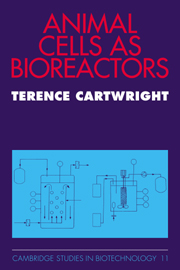Book contents
- Frontmatter
- Contents
- 1 Introducing the animal cell as a bioreactor
- 2 Yields of recombinant product: engineering cells for maximum expression
- 3 Generation of biomass
- 4 Adjusting cellular metabolism for optimum product yield
- 5 Downstream processing
- 6 Regulatory aspects of using cells as bioreactors
- 7 Overview and conclusions
- References
- Index
2 - Yields of recombinant product: engineering cells for maximum expression
Published online by Cambridge University Press: 12 October 2009
- Frontmatter
- Contents
- 1 Introducing the animal cell as a bioreactor
- 2 Yields of recombinant product: engineering cells for maximum expression
- 3 Generation of biomass
- 4 Adjusting cellular metabolism for optimum product yield
- 5 Downstream processing
- 6 Regulatory aspects of using cells as bioreactors
- 7 Overview and conclusions
- References
- Index
Summary
In the case of virus vaccine production, the actual mass of product required, even in the largest-scale application, is low because a little virus goes a long way. However, when the requirements for therapeutic proteins are considered, a different level of productivity becomes necessary because kilograms or tens of kilograms of pure protein may be needed. To avoid completely impractical culture volumes, the specific production rate of protein by the cells (i.e. picograms of protein per cell per hour) must be increased greatly over that which is normal for animal cells, which, with a few notable exceptions such as gamma globulin secreting cells, globin secreting cells and the cells responsible for the production of some digestive enzymes, do not produce protein at a very high rate.
Two basic approaches can be used to achieve high yields of secreted proteins from animal cells. The first involves tapping the existing potential of some cells to produce and secrete large quantities of a given protein under the control of pre-existing synthetic machinery. This is the situation which exists in antibody-producing cells in which high levels of antibody production are obtained due to the presence of powerful transcriptional enhancers for the immunoglobulin genes. The hybridoma technology proposed by Kohler and Milstein (1975) combines this capacity with the immortality of myeloma cell lines. This technique uses somatic hybridization of primary antibody-producing spleen cells with serially propagated myelomas to permit the long-term production of high levels (up to 500 µg/ml) of the required monoclonal antibody in hybrid cells that can be readily adapted to large-scale culture in fermentors.
- Type
- Chapter
- Information
- Animal Cells as Bioreactors , pp. 11 - 41Publisher: Cambridge University PressPrint publication year: 1994
- 1
- Cited by



